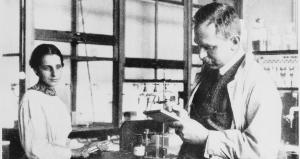The chemical element meitnerium is classed as a transition metal. It was discovered in 1982 by by research scientists led by Peter Armbruster and Gottfried Münzenber.

Data Zone
| Classification: | Meitnerium is a transition metal |
| Color: | |
| Atomic weight: | (278), no stable isotopes |
| State: | solid (presumed) |
| Melting point: | |
| Boiling point: | |
| Electrons: | 109 |
| Protons: | 109 |
| Neutrons in most abundant isotope: | 169 |
| Electron shells: | 2,8,18,32,32,15,2 |
| Electron configuration: | [Rn] 5f14 6d7 7s2 |
| Density @ 20oC: |
Reactions, Compounds, Radii, Conductivities
| Atomic volume: | – |
| Structure: | – |
| Hardness: | – |
| Specific heat capacity | – |
| Heat of fusion | – |
| Heat of atomization | – |
| Heat of vaporization | – |
| 1st ionization energy | – |
| 2nd ionization energy | – |
| 3rd ionization energy | – |
| Electron affinity | – |
| Minimum oxidation number | – |
| Min. common oxidation no. | – |
| Maximum oxidation number | – |
| Max. common oxidation no. | – |
| Electronegativity (Pauling Scale) | – |
| Polarizability volume | – |
| Reaction with air | – |
| Reaction with 15 M HNO3 | – |
| Reaction with 6 M HCl | – |
| Reaction with 6 M NaOH | – |
| Oxide(s) | – |
| Hydride(s) | – |
| Chloride(s) | – |
| Atomic radius | – |
| Ionic radius (1+ ion) | – |
| Ionic radius (2+ ion) | – |
| Ionic radius (3+ ion) | – |
| Ionic radius (1- ion) | – |
| Ionic radius (2- ion) | – |
| Ionic radius (3- ion) | – |
| Thermal conductivity | – |
| Electrical conductivity | – |
| Freezing/Melting point: | – |

Meitnerium is named after Lise Meitner, who discovered nuclear fission. She is shown here in the laboratory with her colleague Otto Hahn.
Discovery of Meitnerium
Meitnerium was first synthesized by research scientists led by Peter Armbruster and Gottfried Münzenber at the Heavy Ion Research Laboratory in Darmstadt, Germany in 1982.
Meitnerium was produced when bismuth-209 was bombarded with accelerated iron-58 nuclei.
The element was named after physicist Lise Meitner.
Appearance and Characteristics
Harmful effects:
Meitnerium is harmful due to its radioactivity.
Characteristics:
Meitnerium is a synthetic, radioactive metal and has only been produced in tiny amounts.
Uses of Actinium
Meitnerium is of scientific research interest only.
Abundance and Isotopes
Abundance earth’s crust: nil
Abundance earth’s crust: nil
Abundance solar system: nil parts per billion by weight, nil parts per trillion by moles
Cost, pure: $ per 100g
Cost, bulk: $ per 100g
Source: Meitnerium is a synthetic radioactive metal, created via nuclear bombardment, and has only been produced in minute amounts. Meitnerium was produced by bombarding 209Bi with 58Fe which produced a single atom of the isotope 266Mt.
Isotopes: Meitnerium has 7 isotopes whose half-lives are known, with mass numbers from 266 to 278. None are stable. The most stable isotope is 278Mt, with a half-life of 8 seconds.

References
Cite this Page
For online linking, please copy and paste one of the following:
<a href="https://www.chemicool.com/elements/meitnerium.html">Meitnerium</a>
or
<a href="https://www.chemicool.com/elements/meitnerium.html">Meitnerium Element Facts</a>
To cite this page in an academic document, please use the following MLA compliant citation:
"Meitnerium." Chemicool Periodic Table. Chemicool.com. 07 Oct. 2012. Web. <https://www.chemicool.com/elements/meitnerium.html>.